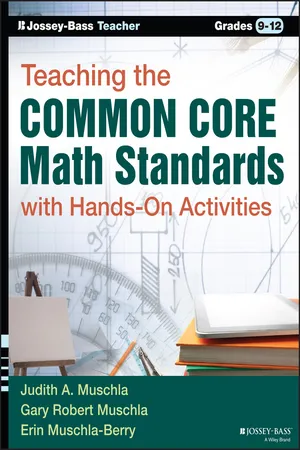Congruence Equations
Congruence equations are mathematical expressions that compare the remainders of two numbers when divided by a third number. They are used to determine if two numbers have the same remainder when divided by a given number. Solving congruence equations involves finding values that satisfy the given congruence relationship.
3 Key excerpts on "Congruence Equations"
- eBook - ePub
Algebra Structure Sense Development amongst Diverse Learners
Theoretical and Empirical Insights to Support In-Person and Remote Learning
- Teresa Rojano, Teresa Rojano(Authors)
- 2022(Publication Date)
- Routledge(Publisher)
...The subsequent section describes the methodological components of the study and, in particular, elaborates on the way in which the tasks were designed. The following two sections present the results of the study and their discussion. The chapter ends with a brief concluding section. (Note that, throughout, our use of the term equality refers to those mathematical objects that contain an equals sign and numerical terms, but no variable or unknown terms; we reserve the term equation for those cases when variables or unknowns are present.) On Mathematical Equivalence While the actual term equivalence and its definition came into use as late as the 20th century, Asghari (2019) recounts the history of this notion as a lived experience that goes back to much earlier times. For example, from Euclid we have that “straight lines parallel to the same straight line are also parallel to one another” and later from Hilbert, “if two segments are congruent to a third one, they are congruent to each other”. The notion of equivalence, even if not called equivalence, has clearly been and remains a fundamental aspect of mathematics. Eventually, mathematical equivalence arrived at its modern definition: An equivalence relation is a binary relation that is reflexive, symmetric, and transitive. The relation “is equal to” is the canonical example of an equivalence relation, where for any objects a, b, and c : a = a (reflexive property); if a = b, then b = a (symmetric property); and if a = b and b = c, then a = c (transitive property). Equality is a relationship between two quantities, or more generally two mathematical expressions, asserting either that the quantities have the same value, or that the expressions represent the same mathematical object, or that an object is being defined – as in π = 3.14159…. With respect to the numerical world, equivalence undeniably has a computational dimension...
- Gary R. Muschla(Author)
- 2015(Publication Date)
- Jossey-Bass(Publisher)
...Section 4 Standards and Activities for Geometry Congruence Congruence is a geometric relationship in which figures have the same shape and size. It can be proven using transformations that preserve distance, such as reflections, rotations, and translations. Two figures are congruent if one or more of these transformations carries a figure onto another so that the figures coincide. G-CO.1 “Experiment with transformations in the plane.” 1. “Know precise definitions of angle, circle, perpendicular line, parallel line, and line segment, based on the undefined notions of point, line, distance along a line, and distance around a circular arc.” Activity: Drawing and Defining Figures Students will draw an angle, circle, perpendicular lines, parallel lines, and a line segment according to written instructions. They will then write a definition for each figure. Materials Ruler; protractor; compass; unlined paper; reproducible G-CO.1, “Instructions for Drawing Figures,” for each student. Optional: Computers with interactive software that students may use to draw the figures. Procedure Explain that geometry is based on three undefined terms: point, line, and plane. An understanding of these terms is necessary to understand other geometric terms and principles. Although point, line, and plane remain undefined, they can be described: A point is represented by a dot. It has no length, width, or thickness. A line has only length; it has no width or thickness. A line extends infinitely in both directions. A plane has length and width. It does not have thickness. Explain that the reproducible contains instructions for drawing five figures. Students are to follow the instructions and draw the figures on the unlined paper (or use interactive software). Once they have drawn each figure, they will name the figure and write a definition for it. Closure Have your students share their drawings...
- eBook - ePub
Understanding Mathematics for Young Children
A Guide for Teachers of Children 3-7
- Derek Haylock, Anne D Cockburn(Authors)
- 2017(Publication Date)
- SAGE Publications Ltd(Publisher)
...This involves recognizing both equivalences and transformations: ways in which shapes can be regarded as being the same and ways in which shapes differ or change. The fact that these concepts of equivalence and transformation are fundamental to understanding both number and shape is one of the reasons why these two aspects of learning are considered to be two branches of one subject. Transformations that might be applied to a shape, in order of increasing distortion of the original shape, are translation, rotation, reflection, similarity, affinity (family likeness), perspectivity and topological transformation. Geometric concepts and language needed to identify and discuss transformations and equivalences in space and shape include: position, here, there, nearer, further, closer, higher, lower, above, below, in front of, behind, direction, up, down, left, right, forwards, backwards, co-ordinates, clockwise, anti-clockwise, angle (dynamic and static), right angle, a quarter, a half and three-quarters of a turn, rotational symmetry, mirror line, line symmetry, congruent, similar, scale factor, scaling up, scaling down, family likeness, parallel, polygon, side, triangle, quadrilateral, pentagon, hexagon, square rectangles and oblong rectangles, parallelogram, rhombus, perspective drawing, path, region, junction, between, next, meet, inside, outside. Suggestions for Further Reading Chapters 24, 25 and 26 of Haylock (2014) explain in more detail the mathematics of angle, transformations, symmetry and the classification of shapes. A chapter by Hejný and Slezáková entitled ‘Investigating mathematical reasoning and decision making’ in Cockburn (2007) provides an interesting range of activities to encourage classification,...


